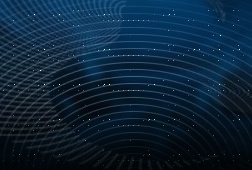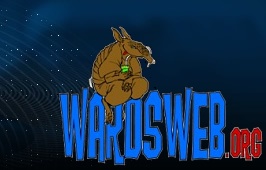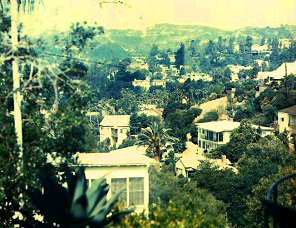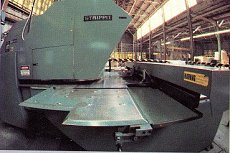


 |
 |
 |
|
 In
and around 1967, this is where it all started. Ted Winchester had the idea to
further develop an audio amplifier designed by his friend, Morris Kessler. It
was a simple idea to build the world's best audio amplifier. No small task but
oh what a challenge. Ted had first met Morris while perusing a local audio shop,
Hi Fi Corner. Morris was designing, building and selling some of his home made
amps while working now at Sound Center.
In
and around 1967, this is where it all started. Ted Winchester had the idea to
further develop an audio amplifier designed by his friend, Morris Kessler. It
was a simple idea to build the world's best audio amplifier. No small task but
oh what a challenge. Ted had first met Morris while perusing a local audio shop,
Hi Fi Corner. Morris was designing, building and selling some of his home made
amps while working now at Sound Center.

Their bench mark was the Marantz Nine, "The" amplifier of the day. So, Ted bought an HP analyzer, an HP 200-CD oscillator [low distortion version] and a Crown IM analyzer. They were ready and set off to design and build the "world's best" audio amplifier. To achieve this, the amp had to pass Ted's "screw driver death test" ( any frequency 20Hz to 20KHz, sine wave driven amp to full power, then short the output terminals with a screw driver). Needless to say this produced a lot of dead 2N3055's, but it also produced the fruit of their labor, the Mark Two.
Scientific Audio Electronics (SAE) was officially commenced
in 1968 with a Partnership Agreement ![]() between
Ted Winchester, Morris Kessler and Beth Winchester. They needed a logo, so Ted
took out some Bishop Graphics PC board drafting tape and designed the stylized
"S" and "E" symmetrical with the "A", SAE was
born.
between
Ted Winchester, Morris Kessler and Beth Winchester. They needed a logo, so Ted
took out some Bishop Graphics PC board drafting tape and designed the stylized
"S" and "E" symmetrical with the "A", SAE was
born.
The Mark Two was no beauty, but it didn't have the "transistor
sound" like other amplifiers of the day. Still it was difficult to sell
an "orphan" power amp to the audio  emporiums
of the day. Their customers wanted the Marantz and Macintosh full-line with
front panels/rack cases look. That changed with a review in Stereophile. Gordon
Holt was reluctant at first to review the "orphan" amplifier that
was not available nationally. On the telephone, in effect he said, "Well
you (Ted) have made me curious and either you and your friends all have tin
ears if you and they think it's the solid-state equivalent of the Marantz Nine
or you've made the only solid-state amp worth buying. Gordon's most generous
praise of the Mark Two in Stereophile most likely started the SAE legend.
emporiums
of the day. Their customers wanted the Marantz and Macintosh full-line with
front panels/rack cases look. That changed with a review in Stereophile. Gordon
Holt was reluctant at first to review the "orphan" amplifier that
was not available nationally. On the telephone, in effect he said, "Well
you (Ted) have made me curious and either you and your friends all have tin
ears if you and they think it's the solid-state equivalent of the Marantz Nine
or you've made the only solid-state amp worth buying. Gordon's most generous
praise of the Mark Two in Stereophile most likely started the SAE legend.
 In
the early 70's, Ted was designing and manufacturing graphic equalizers separately
under Linear Transducer Designs (LTD) that SAE marketed through the mid 70's.
All LTD manufactured SAE equalizers and SAE preamp-equalizers are identifiable
by the "Copyright LTD 19XX" on every circuit board except the Mark
1B.
In
the early 70's, Ted was designing and manufacturing graphic equalizers separately
under Linear Transducer Designs (LTD) that SAE marketed through the mid 70's.
All LTD manufactured SAE equalizers and SAE preamp-equalizers are identifiable
by the "Copyright LTD 19XX" on every circuit board except the Mark
1B.
Along the way, Morris was joined by the likes of the great Ed Miller and James Bongiorno, to name just a couple. Morris sold SAE, Inc. in 1988 to a company that in turn sold it to DAC. They were trying to reach the masses and had the SAE TWO line built overseas. It was the beginning of the end for the SAE banner.
James Bongiorno started GAS (Great American Sound) which also built some classic amps, like the Ampzilla & Grandson. Bongiorno sold GAS and started a third company, Sumo, and designed still more classic amps, and a tuner called Charlie the Tuner. Then in June of 1994 Morris Kessler and Mike Pontelle joined under the banner of Amplifier Technologies, Inc. ( ATI ) .
For almost two decades, SAE made some of the best known home audio amplifiers. In the early Seventies, if one wanted the best in solid-state amplification, SAE came to mind. Known then internationally as purveyors of open and musical products, SAE lingers in the minds of audiophiles old enough to remember as a company that really produced. These amps were so popular, they took Japan by storm way before single-ended tube amps became retro-cool in the land of the rising Sun.